Denise Sutherland's Blog, page 8
October 31, 2012
Clever reCAPTCHA
Thank you! Thank you so much for helping to correct thousands, if not millions, of pages of scanned text!
What? You aren't doing anything of the sort? Oh, yes you are ... read on!
Optical character recognition (OCR) is the method used to digitise printed material — old newspapers and book, for example, can be scanned using OCR technology, and then we can access them online. The National Library of Australia uses this technology for its massive Trove database, for example.
The problem with OCR is that it's not always that accurate, especially from older printed material with yellowing paper and faded or smudged ink. It is a lot better than it used to be, but is still far from 100% accurate — 80% accuracy is more typical. So the resulting scanned texts have a lot of errors!
Here's an example:

We can read the top sentence of scanned type (This aged portion of society were distinguished from), but a computer has a lot of trouble distinguishing the letter patterns. The human eye is just better at it!
So, there's a problem. We have millions of pages of inaccurate scanned text, with 20% errors. Which makes it difficult to read and use, needless to say.
Now, you'll be familiar with CAPTCHA technology already. CAPTCHA stands for 'Completely Automated Public Turing test to tell Computers and Humans Apart'. It's those range of 'verification' boxes that pop up when posting on a blog or registering for something online, for example. You might need to type in some letters, deciphering a mangled or warped picture, or do some sums, or something which proves that you're a real person using the site, and not a computer being used by spammers to abuse online services. You're doing something that a computer can't do.
Some bright lads over at the Computer Science Department at Carnegie Mellon University (PA, USA) came up with a clever tool to help solve this problem, called reCAPTCHA.

This is a variety of CAPTCHA entry box, where one of the two 'distorted' words presented for you to retype is a word from actual scanned texts, which was unrecognisable by OCR. The other word is a 'control' word, to assess how accurate you are when typing in entries. Readings for these distorted words need to be agreed on by several users before they are cleared as being accurate.
In their Science paper reCAPTCHA: Human-Based Character Recognition via Web Security Measures (which you can download from this page), the scientists say that reCAPTCHA is used by more than 40,000 websites in 2008 (and presumably many more by now), and is proving to be highly effective and accurate.
You can read more about reCAPTCHA on Google and Wikipedia.
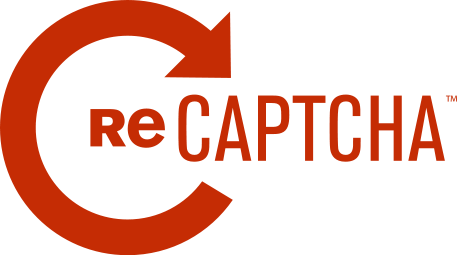
So whenever you enter text into a word verification box with this logo on it, you're helping to correct the vast quantities of old scanned texts, for all! I think it's so clever; we're all helping to improve information and assisting in a massive complex process. And every one of us is contributing, whether we know it or not.
So — thank you!
Images from http://www.google.com/recaptcha/

What? You aren't doing anything of the sort? Oh, yes you are ... read on!
Optical character recognition (OCR) is the method used to digitise printed material — old newspapers and book, for example, can be scanned using OCR technology, and then we can access them online. The National Library of Australia uses this technology for its massive Trove database, for example.
The problem with OCR is that it's not always that accurate, especially from older printed material with yellowing paper and faded or smudged ink. It is a lot better than it used to be, but is still far from 100% accurate — 80% accuracy is more typical. So the resulting scanned texts have a lot of errors!
Here's an example:

We can read the top sentence of scanned type (This aged portion of society were distinguished from), but a computer has a lot of trouble distinguishing the letter patterns. The human eye is just better at it!
So, there's a problem. We have millions of pages of inaccurate scanned text, with 20% errors. Which makes it difficult to read and use, needless to say.
Now, you'll be familiar with CAPTCHA technology already. CAPTCHA stands for 'Completely Automated Public Turing test to tell Computers and Humans Apart'. It's those range of 'verification' boxes that pop up when posting on a blog or registering for something online, for example. You might need to type in some letters, deciphering a mangled or warped picture, or do some sums, or something which proves that you're a real person using the site, and not a computer being used by spammers to abuse online services. You're doing something that a computer can't do.
Some bright lads over at the Computer Science Department at Carnegie Mellon University (PA, USA) came up with a clever tool to help solve this problem, called reCAPTCHA.

This is a variety of CAPTCHA entry box, where one of the two 'distorted' words presented for you to retype is a word from actual scanned texts, which was unrecognisable by OCR. The other word is a 'control' word, to assess how accurate you are when typing in entries. Readings for these distorted words need to be agreed on by several users before they are cleared as being accurate.
In their Science paper reCAPTCHA: Human-Based Character Recognition via Web Security Measures (which you can download from this page), the scientists say that reCAPTCHA is used by more than 40,000 websites in 2008 (and presumably many more by now), and is proving to be highly effective and accurate.
You can read more about reCAPTCHA on Google and Wikipedia.

So whenever you enter text into a word verification box with this logo on it, you're helping to correct the vast quantities of old scanned texts, for all! I think it's so clever; we're all helping to improve information and assisting in a massive complex process. And every one of us is contributing, whether we know it or not.
So — thank you!
Images from http://www.google.com/recaptcha/
Published on October 31, 2012 17:48
October 23, 2012
Quick Break

I'm very excited to announce that my first app is up for sale on the iTunes App Store!
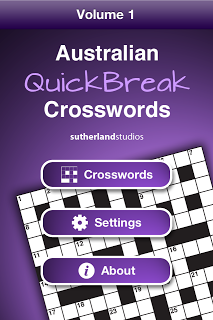
My husband Ralph and I have been working on this for ages — he is the expert code monkey, and I've done the graphics and written all the crosswords.
My Quick Break crosswords have appeared for years in The Cairns Post. They are 13 x 13 quick crosswords (not cryptic), and mostly quite easy to solve, with the occasional tricky word.
I am no longer doing syndicated puzzles for newspapers (a rapidly dying field), so apps are the way forward.
This first volume contains 50 of my Quick Break crosswords. Volumes 2, 3 and 4 are in production.
Here are some screen shots to entice you!
 Just tap on the grid to bring up the keyboard, then start typing in your answers:
Just tap on the grid to bring up the keyboard, then start typing in your answers:
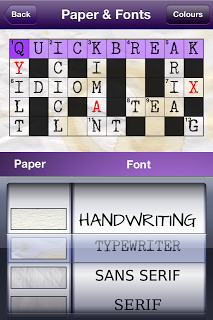 You can choose from four fonts and nine background papers, including dark papers and crumpled paper with coffee stains!
You can choose from four fonts and nine background papers, including dark papers and crumpled paper with coffee stains!
 And you can choose the colours for everything - the grid, the text, and the highlight colours.
And you can choose the colours for everything - the grid, the text, and the highlight colours.As I have vision problems, we have been very aware of accessibility issues. Some people with visual impairments find white text on a dark background easier to read, for example — with this app, you can do that. You can also zoom in on the grid, and set the app to do this automatically for you, if you wish.
Other options are marking wrong letters in red, having a timer, and locking correct letters. Typing a '?' will reveal the letter for the selected square. These 'cheated' letters have a red triangle in their corner.
It works on iPhones (including the 5), iPods, and iPads. It's waiting for you now!
Published on October 23, 2012 22:07
October 14, 2012
Missing in Action
Apologies for the silence here — I'm doing a short contract as a publications editor for Early Childhood Australia, and don't have the time to write for the blog. Normal service shall resume next week!
xo Denise
xo Denise
Published on October 14, 2012 14:22
September 30, 2012
Goodreads
Phill Berrie has very kindly posted his review of Solving Cryptic Crosswords For Dummies on Goodreads.
Thanks Phill!
Thanks Phill!
Published on September 30, 2012 19:39
September 24, 2012
The Quirkology Index
As well as writing puzzles, I am also an editor and indexer (cos, let's face it, writing puzzles is no way to earn an income!).
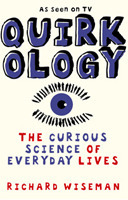 As an indexing exercise, I recently finished writing an index for the book Quirkology, by Richard Wiseman. A really fascinating book that suffers from the lack of an index.
As an indexing exercise, I recently finished writing an index for the book Quirkology, by Richard Wiseman. A really fascinating book that suffers from the lack of an index.You are welcome to download the PDF of the index for free, and print it out. Then you can refer to it when reading your copy of the book!
There are two versions of the file:
A4 Quirkology Index
This index is a straight forward layout, on A4 (will resize to US Letter easily), and you can print it either single or double-sided as you prefer. Staple them together.

Booklet Quirkology Index
This file has been designed to make a little booklet that can be slotted into the back of your copy of Quirkology. To use this file, you need to be able to print double-sided, and to trim pages to the size of your copy of the book (using a ruler and blade, paper guillotine etc).
The pages are laid out in imposition, so they may look in a funny order, but once the pages are folded in half, and the booklet is put together, trust me, it will work out.
You may need to flip every second page by 180º to get the printing to work correctly, it depends on how your printer does double-sided printing.
After printing, fold the pages in half, place them together in the correct order (you'll be able to tell from the alphabetical order), and trim them to size (there are trim marks on the pages to guide you). Then simply plonk it into the back of your copy of Quirkology, and you're set to go!
Published on September 24, 2012 17:08
September 11, 2012
Lesson 8: Reversals
So. Reversals. I bet you have already figured out how this cryptic wordplay works! Yes indeed, some letters or words are run backwards to help get to the answer.
In English, some words are perfect reversals of each other - TIPS / SPIT, SERIF / FIRES, GUM / MUG, and KEEP / PEEK are just a few. These sorts of words are called anadromes.
And you will know what palindromes are no doubt, those tricky words which read the same backwards and forwards! EVE, RADAR, TOT, and so on.

In cryptic clues, either the whole answer word can be clued with a "perfect" reversal (eg WOLF reversing to give FLOW), or as is more common, (let's face it, not that many words form perfect anadromes), the reversal forms part of the wordplay, in combination with another device (especially charades). They also have reversal indicator words, so you get some instruction on what to do.
Here's an example of a "pure" reversal clue:
Pam runs back to get a chart (3)
Pam is the word that you're going to reverse, runs back is the reversal indicator, and a chart is the definition. MAP is the answer (PAM reversed).
More often than not, though, you won't be given the word to reverse 'in the clear' (as in the clue above). You will need to find it by locating a synonym for a word in the wordplay part of the clue. such as:
Keen opera singer is going the wrong way (4)
In this clue, keen is the definition. This means that opera singer is going the wrong way is the wordplay. Is going the wrong way is the reversal indicator, and opera singer is what to reverse ...
But, this doesn't lead to anything that's sensible (REGNIS AREPO, although it sounds like something Captain Kirk might use to name a new planet). So let's look for a synonym for opera singer that is 4 letters long. ALTO? Hmm, OTLA isn't promising. How about DIVA? Reverse this word, and you get AVID, which nicely matches with the definition!
One more example, of how a reversal can be used in combination with another device (fairly commonly with a charade clue, with an abbreviation tacked on somewhere).
Diana ran back to get Iranian currency (5)
In this clue, Iranian currency is the definition. Diana is abbreviated to DI, and then add on ran back = NAR (backwards). DI + NAR = DINAR!
Reversal Indicators
As you can see, reversal indicators are words or short phrases that give a sense of something being turned over, reversed, sent back, returned, or pushed over.
All reversal indicators can be used with both Across and Down clues - however ones that give a sense of 'rising' or 'going up' can only be used with Down clues (as the words are written into the grid from top to bottom, therefore a reversal would effectively be written from bottom to top).
Here are just a few reversal indicator words. There is a more complete list on my website. The Down-only clue reversal indicators on this list are marked with an ^.
aboutarising ^back-to-frontclimbing up ^contrariwisefrom the Eastgo back in retrospectkeep backknock overlooking up ^overturnedrecoilingreflected rejectrising ^send up ^set backtake up ^turn backupset ^
Practice Reversal Clues
Now it's your turn! Remember that each of the these clues has the definition, at the start or end of the clue, and the wordplay (which you know is a reversal).
1. Boast - lifted up attire! (4) (Down clue)
2. Have a quick look both ways (4)
3. Wind, backtracking, to get to swimming place (4)
4. Round feline and tenor show discretion (4)
5. A young boy and Sal return to Texan city (6)
As ever, there is a cute puppeh guardian, looking after the explanations and clues. Scroll past Griff (who just turned 1!) when you're ready. It'll be easy, he's neglecting his duties!
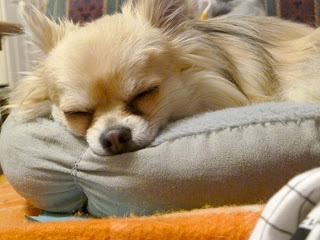
Explanations
1. Boast - lifted up attire! (4) (Down clue) Lifted up is the reversal indicator here. Attire is the definition. You need to find a synonym for the word boast (which starts with B) and reverse that, to get the answer.
2. Have a quick look both ways (4) Both ways is a palindrome indicator - the answer reads the same in both directions. Have a quick look is the definition. There isn't a word to find a synonym for, as it's the same as the answer when reversed!
3. Wind, backtracking, to get to swimming place (4)
Did you spot the reversal indicator? Yes, it's backtracking. Swimming place is the definition, and wind is the word to find a synonym for and reverse, to get to the answer. The synonym for wind starts with L.
4. Round feline and tenor show discretion (4)
This clue is a little tricker! This clue combines a reversal with an abbreviation, in a charade (one bit after another). The reversal indicator is a bit harder to pin down - it's round (as in turning around, not the circular shape!). Discretion is the definition here. A feline is also a CAT. Tenor is often abbreviated as T. You know how to do the rest!
5. A young boy and Sal return to Texan city (6)
This clue is a charade of two reversals put next to each other! A young boy = LAD, and Sal = SAL. Return is the reversal indicator, and Texan city is the definition.
Answers
1. GARB
2. PEEP
3. POOL
4. TACT
5. DALLAS
In English, some words are perfect reversals of each other - TIPS / SPIT, SERIF / FIRES, GUM / MUG, and KEEP / PEEK are just a few. These sorts of words are called anadromes.
And you will know what palindromes are no doubt, those tricky words which read the same backwards and forwards! EVE, RADAR, TOT, and so on.

In cryptic clues, either the whole answer word can be clued with a "perfect" reversal (eg WOLF reversing to give FLOW), or as is more common, (let's face it, not that many words form perfect anadromes), the reversal forms part of the wordplay, in combination with another device (especially charades). They also have reversal indicator words, so you get some instruction on what to do.
Here's an example of a "pure" reversal clue:
Pam runs back to get a chart (3)
Pam is the word that you're going to reverse, runs back is the reversal indicator, and a chart is the definition. MAP is the answer (PAM reversed).
More often than not, though, you won't be given the word to reverse 'in the clear' (as in the clue above). You will need to find it by locating a synonym for a word in the wordplay part of the clue. such as:
Keen opera singer is going the wrong way (4)
In this clue, keen is the definition. This means that opera singer is going the wrong way is the wordplay. Is going the wrong way is the reversal indicator, and opera singer is what to reverse ...
But, this doesn't lead to anything that's sensible (REGNIS AREPO, although it sounds like something Captain Kirk might use to name a new planet). So let's look for a synonym for opera singer that is 4 letters long. ALTO? Hmm, OTLA isn't promising. How about DIVA? Reverse this word, and you get AVID, which nicely matches with the definition!
One more example, of how a reversal can be used in combination with another device (fairly commonly with a charade clue, with an abbreviation tacked on somewhere).
Diana ran back to get Iranian currency (5)
In this clue, Iranian currency is the definition. Diana is abbreviated to DI, and then add on ran back = NAR (backwards). DI + NAR = DINAR!
Reversal Indicators
As you can see, reversal indicators are words or short phrases that give a sense of something being turned over, reversed, sent back, returned, or pushed over.
All reversal indicators can be used with both Across and Down clues - however ones that give a sense of 'rising' or 'going up' can only be used with Down clues (as the words are written into the grid from top to bottom, therefore a reversal would effectively be written from bottom to top).
Here are just a few reversal indicator words. There is a more complete list on my website. The Down-only clue reversal indicators on this list are marked with an ^.
aboutarising ^back-to-frontclimbing up ^contrariwisefrom the Eastgo back in retrospectkeep backknock overlooking up ^overturnedrecoilingreflected rejectrising ^send up ^set backtake up ^turn backupset ^
Practice Reversal Clues
Now it's your turn! Remember that each of the these clues has the definition, at the start or end of the clue, and the wordplay (which you know is a reversal).
1. Boast - lifted up attire! (4) (Down clue)
2. Have a quick look both ways (4)
3. Wind, backtracking, to get to swimming place (4)
4. Round feline and tenor show discretion (4)
5. A young boy and Sal return to Texan city (6)
As ever, there is a cute puppeh guardian, looking after the explanations and clues. Scroll past Griff (who just turned 1!) when you're ready. It'll be easy, he's neglecting his duties!

Explanations
1. Boast - lifted up attire! (4) (Down clue) Lifted up is the reversal indicator here. Attire is the definition. You need to find a synonym for the word boast (which starts with B) and reverse that, to get the answer.
2. Have a quick look both ways (4) Both ways is a palindrome indicator - the answer reads the same in both directions. Have a quick look is the definition. There isn't a word to find a synonym for, as it's the same as the answer when reversed!
3. Wind, backtracking, to get to swimming place (4)
Did you spot the reversal indicator? Yes, it's backtracking. Swimming place is the definition, and wind is the word to find a synonym for and reverse, to get to the answer. The synonym for wind starts with L.
4. Round feline and tenor show discretion (4)
This clue is a little tricker! This clue combines a reversal with an abbreviation, in a charade (one bit after another). The reversal indicator is a bit harder to pin down - it's round (as in turning around, not the circular shape!). Discretion is the definition here. A feline is also a CAT. Tenor is often abbreviated as T. You know how to do the rest!
5. A young boy and Sal return to Texan city (6)
This clue is a charade of two reversals put next to each other! A young boy = LAD, and Sal = SAL. Return is the reversal indicator, and Texan city is the definition.
Answers
1. GARB
2. PEEP
3. POOL
4. TACT
5. DALLAS
Published on September 11, 2012 23:09
September 2, 2012
Gemini 6361
This is the Gemini Cryptic from Friday 31 August's Canberra Times. And what a freezing cold snowy day it was! Best to be curled up inside with a hot cup of something and a nice cryptic to work out.
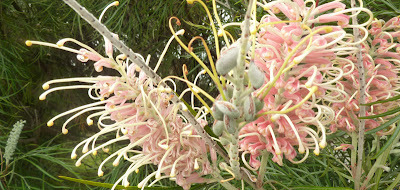
As usual, the definition is underlined, except in double definition and cryptic definition clues.
ACROSS
1. Has second thoughts about a hundred workers (7) = RECANTS
Charade. About = RE + a = A + hundred = C + workers = ANTS
5. Approaches a listener in two directions (5) = NEARS
A container clue. A listener = EAR, put in two directions (North and South) > N(EAR)S
8. Dead Roman exchanged for wife of Perseus (9) = ANDROMEDA
An anagram (exchanged) of dead Roman.
9. Left with a thousand to beat (3) = LAM
Charade. Left = L + a = A + thousand= M
10. They take turns on and off (4) = TAPS
Cryptic definition. Taps turn, and turn on and off ...
12. Plant it in haste (8) = CELERITY
Container. Put it in a plant (CELERY) - CELER(IT)Y
14. Display by top-class band (6) = AIRING
Charade clue. Top-class = AI (from A1, and the 1 looks like an upper case I) + band = RING (not a musical group!)
15. Published and is prosecuted (6) = ISSUED
Double definition. Slightly dubious, I think. You can be ISSUED with a formal notice, or it can be something under discussion (but I'm not sure of the 'being prosecuted' meaning). And published = ISSUED
17. Sticking together he said no changes are needed (8) = ADHESION
Anagram of he said no, indicated by changes are needed
18. Ring maker (4) = BELL
Cryptic definition - a bell makes ringing sounds!
21. A religious palindrome (3) = NUN
Palindrome. Someone who is bound by monastic vows, such as a nun, is also known as 'a religious'. And nun is a palindrome, reading the same way in both directions!
22. It may help to rescue a country from mad policy (9) = DIPLOMACY
Anagram clue, which is unfair. There is no anagram indicator. The anagram fodder is mad policy, and the setter has used mad twice (what's called 'double duty') - as part of the fodder, and (unfairly) as the anagram indicator as well. A fairer clue would read along the lines of It may help to rescue a country from insanely mad policy, where insanely is the anagram indicator.
24. Cask Edward put into good order (5) = TUNED
Charade. A TUN is a large beer or wine cask. Add on ED for Edward, shortened.
25. He has something to say on the radio (7) = SPEAKER
Double definition. The first definition is He has something to say, and the second one is [something you can find] on the radio.
DOWN
1. Respond - to an encore call? (5) = REACT
Double definition. The first definition is respond. The second one is a bit of language abuse, indicated by the question mark. If you get an encore, you might be being asked to act again, or RE-ACT.
2. Fish paid for at the door (3) = COD
Double definition. A COD is a type of fish, and C.O.D. is Cash On Delivery, or paid for at the door
3. Either way it's high time (4) = NOON
Palindrome. High noon!
4. Embarrassing moments in parts of the play (6) = SCENES
Double definition. The first definition is embarrassing moments, the second one is parts of the play
5. Possibly ten areas mostly in southwest Asia (4,4) = NEAR EAST
Anagram, indicated by possibly. The fodder is ten areas.
6. Not occupied? There's no hurry (2,7) = AT LEISURE
Double definition. I think these two definitions are really a bit too close in meaning, though, to be a good double definition clue.
7. Breed of dog that will change some day (7) = SAMOYED
Anagram, indicated by change. The fodder is some day.
11. Separate layer on ruined temple (9) = PARTHENON
Charade. Separate = PART + layer = HEN + on = ON
13. It could be indeed so unfair (3-5) = ONE-SIDED
Anagram of indeed so, indicated by it could be.
14. Opposed to making a profit. Good man! (7) = AGAINST
Charade. A profit = A GAIN + good man = ST (for saint). Ignore the punctuation!
16. Manages adequately round a bend in two-door cars (6) = COUPES
Container. Manages adequately = COPES. Put it round the letter U (a bend - a u-bend, like in a sink) = CO(U)PES
19. A better bed (5) = LAYER
Double definition, I think ... a better is someone who lays a bet, therefore a layer? Bit of language abuse there. And a bed can also be a layer (especially in geology).
20. Knows the sound of an organ (4) = NOSE
Homophone clue - the sound of 'knows' is the name of an organ.
23. Put a question like 'the capital of Kenya?' (3) = ASK
Charade. Like = AS + K (the capital [letter] of Kenya)


As usual, the definition is underlined, except in double definition and cryptic definition clues.
ACROSS
1. Has second thoughts about a hundred workers (7) = RECANTS
Charade. About = RE + a = A + hundred = C + workers = ANTS
5. Approaches a listener in two directions (5) = NEARS
A container clue. A listener = EAR, put in two directions (North and South) > N(EAR)S
8. Dead Roman exchanged for wife of Perseus (9) = ANDROMEDA
An anagram (exchanged) of dead Roman.
9. Left with a thousand to beat (3) = LAM
Charade. Left = L + a = A + thousand= M
10. They take turns on and off (4) = TAPS
Cryptic definition. Taps turn, and turn on and off ...
12. Plant it in haste (8) = CELERITY
Container. Put it in a plant (CELERY) - CELER(IT)Y
14. Display by top-class band (6) = AIRING
Charade clue. Top-class = AI (from A1, and the 1 looks like an upper case I) + band = RING (not a musical group!)
15. Published and is prosecuted (6) = ISSUED
Double definition. Slightly dubious, I think. You can be ISSUED with a formal notice, or it can be something under discussion (but I'm not sure of the 'being prosecuted' meaning). And published = ISSUED
17. Sticking together he said no changes are needed (8) = ADHESION
Anagram of he said no, indicated by changes are needed
18. Ring maker (4) = BELL
Cryptic definition - a bell makes ringing sounds!
21. A religious palindrome (3) = NUN
Palindrome. Someone who is bound by monastic vows, such as a nun, is also known as 'a religious'. And nun is a palindrome, reading the same way in both directions!
22. It may help to rescue a country from mad policy (9) = DIPLOMACY
Anagram clue, which is unfair. There is no anagram indicator. The anagram fodder is mad policy, and the setter has used mad twice (what's called 'double duty') - as part of the fodder, and (unfairly) as the anagram indicator as well. A fairer clue would read along the lines of It may help to rescue a country from insanely mad policy, where insanely is the anagram indicator.
24. Cask Edward put into good order (5) = TUNED
Charade. A TUN is a large beer or wine cask. Add on ED for Edward, shortened.
25. He has something to say on the radio (7) = SPEAKER
Double definition. The first definition is He has something to say, and the second one is [something you can find] on the radio.
DOWN
1. Respond - to an encore call? (5) = REACT
Double definition. The first definition is respond. The second one is a bit of language abuse, indicated by the question mark. If you get an encore, you might be being asked to act again, or RE-ACT.
2. Fish paid for at the door (3) = COD
Double definition. A COD is a type of fish, and C.O.D. is Cash On Delivery, or paid for at the door
3. Either way it's high time (4) = NOON
Palindrome. High noon!
4. Embarrassing moments in parts of the play (6) = SCENES
Double definition. The first definition is embarrassing moments, the second one is parts of the play
5. Possibly ten areas mostly in southwest Asia (4,4) = NEAR EAST
Anagram, indicated by possibly. The fodder is ten areas.
6. Not occupied? There's no hurry (2,7) = AT LEISURE
Double definition. I think these two definitions are really a bit too close in meaning, though, to be a good double definition clue.
7. Breed of dog that will change some day (7) = SAMOYED
Anagram, indicated by change. The fodder is some day.
11. Separate layer on ruined temple (9) = PARTHENON
Charade. Separate = PART + layer = HEN + on = ON
13. It could be indeed so unfair (3-5) = ONE-SIDED
Anagram of indeed so, indicated by it could be.
14. Opposed to making a profit. Good man! (7) = AGAINST
Charade. A profit = A GAIN + good man = ST (for saint). Ignore the punctuation!
16. Manages adequately round a bend in two-door cars (6) = COUPES
Container. Manages adequately = COPES. Put it round the letter U (a bend - a u-bend, like in a sink) = CO(U)PES
19. A better bed (5) = LAYER
Double definition, I think ... a better is someone who lays a bet, therefore a layer? Bit of language abuse there. And a bed can also be a layer (especially in geology).
20. Knows the sound of an organ (4) = NOSE
Homophone clue - the sound of 'knows' is the name of an organ.
23. Put a question like 'the capital of Kenya?' (3) = ASK
Charade. Like = AS + K (the capital [letter] of Kenya)
Published on September 02, 2012 23:24
August 31, 2012
Lesson 101
On Friday 31 August I was interviewed by Louise Maher on ABC 666 Canberra's Drive program, for their "Lesson 101" slot.
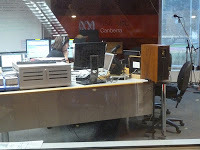

You can read about and hear the interview here.



You can read about and hear the interview here.
Published on August 31, 2012 17:15
August 28, 2012
The Books' Launch
On Saturday 25th August we all gathered at Paperchain Bookstore in Manuka to celebrate the launch of Solving Cryptic Crosswords For Dummies and Cryptic Crosswords For Dummies!

My second technical editor, Deborah Green came from interstate for the event, and stayed with us overnight. We all got dolled up — the crossword corset had its first outing — and headed for Manuka, with a car full of nommy goodies!
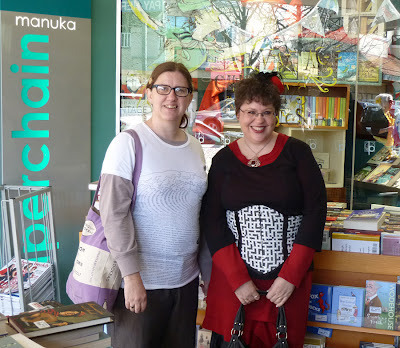
This was a really exciting day for me, as — although I have written 5 books now — these are the first ones I've had a proper book launch for.
The place was packed — 50 or 60 people came along, many of whom were long-lost friends, as well as many new friends and family. Indexers and BookCrossers were well represented!
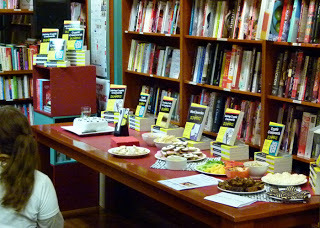



My high school English teacher (now principal of Narrabundah College) Kerrie Grundy gave the introductory speech. I won't mention how long ago it was that she taught me!

I then gave my 15 minute talk. No-one dozed off, so I think I'm ahead there!
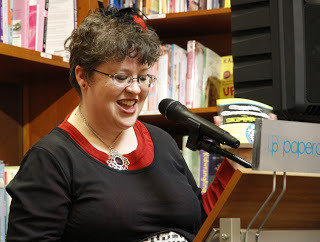

And then we cut the cake, and chat, food and drink flowed freely!
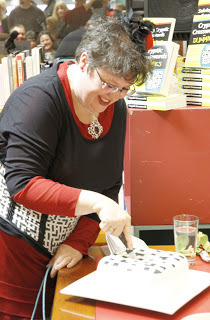
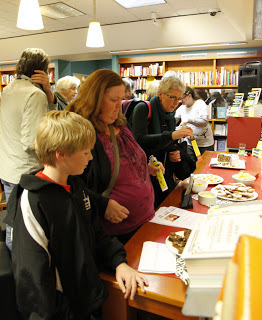
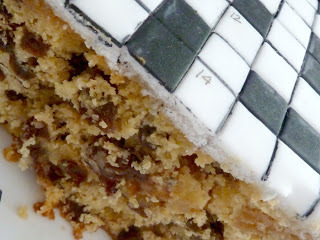
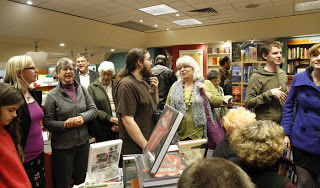
I spent the rest of the launch behind the front counter, signing books ... so I didn't get to chat with everyone or mingle as much as I'd have liked, but that was par for the course. Deborah did a sterling job of managing the food table.
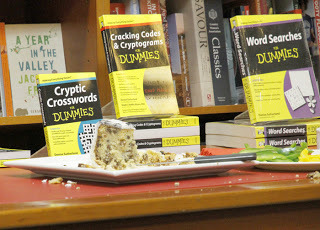

Paperchain and Wiley are very impressed that we sold 60 books at the launch - 35 of Solving Cryptic Crosswords For Dummies, and 25 of Cryptic Crosswords For Dummies!
It was a really wonderful event, it was great to see so many friends and family, some of whom had driven from afar, and to launch these two little books into the world with such fun and love! Thank you Troy for the Olympic teatowel and autographed copy of his book, Penny and Alex, and Margaret for the gorgeous flowers, Kirsty for the champagne, and Kate and Tilly for luscious yarn gifts (and a leaf, don't forget the leaf!).
Thank you everyone!
Photos by Barry Newell, Rodger Sutherland, and Ralph Sutherland - thank you guys!
Published on August 28, 2012 19:01
August 23, 2012
How to Make a Crossword Cake
I've made these crossword cakes for the books' launch at the end of this month. I thought you might be interested in the recipe, which is a family favourite, and the method.
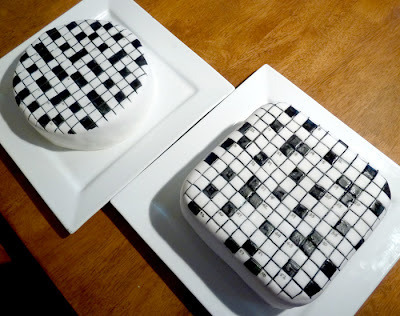
The recipe is my great-aunt's fruit cake. It's a boiled fruit cake, which means the dried fruit is boiled before baking, which makes it all soft and tender and nommy. This is the cake I made for my wedding cake, many years ago, in the mists of time.
It is also a very easy and inexpensive cake to make (always a plus)! Keep in mind that the whole decorating process takes quite a few days (as the marzipan layer needs to dry first), so this isn't a project to undertake in a rush at the last minute. There are quicker crossword biscuits at the end of this post, if you are in a hurry.
Aunty Joyce's Fruit Cake
500g sultanas120g dried orange peel (or you can substitute another dried fruit if you're not a fan of peel)250 g butter, chopped1 cup sugar1 cup plain flour1 cup self-raising flour3 eggs60-90 ml brandy
You will need:
a large saucepan - all mixing is done in the saucepan, so make sure it's large!a knife for cutting the buttera mixing spoonmeasuring cupsdeep cake panskewer of some sort for testing donenesswire cake cooling rack
1. Put the sultanas and peel (or chopped dried apricots, or currants, or whatever) into a large saucepan. Pour in enough water to cover the fruit. Bring to the boil, then simmer until all the liquid is absorbed, stirring occasionally. Remove from the heat.
2. Preheat the oven to 175ºC (NOT fan forced) or 165º fan-forced.
3. Stir in the chopped butter and sugar, mix until the sugar is dissolved and the butter is melted.
My goodness, doesn't it look yummy?

4. Mix in the flours, eggs, and brandy.
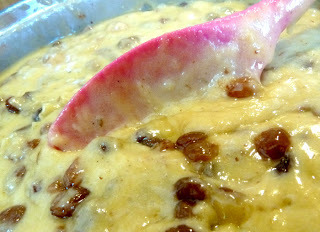
5. Grease and line a deep cake tin. If you're using a silicone pan, you don't need to line it, just greasing will do. Pour in the batter.
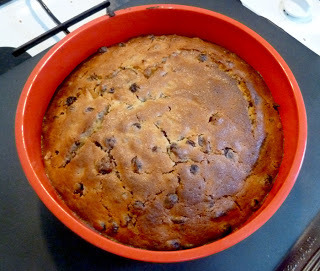 6. Bake! My cakes usually take 70 minutes, but test yours at one hour. Allow to cool in the tin for a bit, then on a wire rack.
6. Bake! My cakes usually take 70 minutes, but test yours at one hour. Allow to cool in the tin for a bit, then on a wire rack.
At this point you can just either wrap it in foil, to ice another day, or proceed to icing right away.
The Crossword Decoration
I got the basic idea and method for how to do this from the Cake or death? website (see the cryptic crossword cake close up, and Janet's decoration technique). This is her cryptic crossword cake, which I love. Looks, an icing pencil! She's gone as far as adding custom cryptic clues, a step I haven't done (this time!) ... the by Araucakia line is hilarious (a take on Araucaria, a famous UK cryptic setter). I also highly approve of her Eddie Izzard Cake or death? connection!

You will need:
apricot jammarzipan or almond cake paste (~600g)fondant icing (~600g)icing sugar (for dusting)black paste food colouringblack edible ink pen – I used the Jet Black Edible Food Penrolling pinpastry brushtiny paintbrushclean rulerprint out of an enlarged crossword
1. You need a basic marzipan and fondant icing coating on the cake. There are many online tutorials and videos on how to do this; I found these two useful:
How to marzipan a cake (VideoJug)Icing a fruit cake (BBC Good Food)
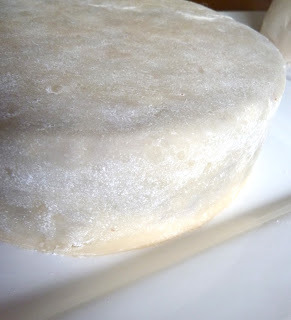 The marzipan layerBasically, you coat the cake with a thin layer of strained, warm apricot jam. Then you roll out the marzipan layer and cover the cake with it. Then the cake needs to dry for several days. Finally, you roll out the fondant icing, and cover the cake with that.
The marzipan layerBasically, you coat the cake with a thin layer of strained, warm apricot jam. Then you roll out the marzipan layer and cover the cake with it. Then the cake needs to dry for several days. Finally, you roll out the fondant icing, and cover the cake with that.
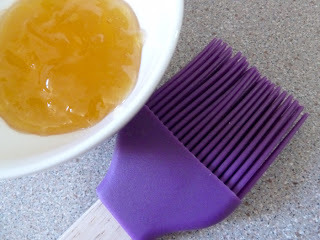 The apricot glaze ready to go
The apricot glaze ready to go
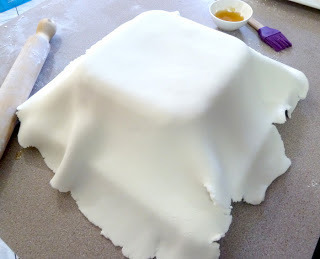 Adding the fondant layer
Adding the fondant layer
 All neat and tidy!
All neat and tidy!
Once the fondant icing has dried for a bit (at least 4-5 hours):
2. Using the back of a knife, or a very clean ruler edge, lightly press a regular grid design into the top of the cake. You don't want the lines to press down too far into the icing. You can also photocopy a crossword (enlarged) and use that as a guide, running a blunt edge over the lines, to lightly mark the icing surface.
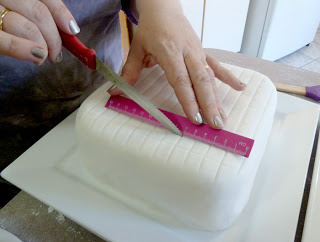 Ruling up the cake
Ruling up the cake
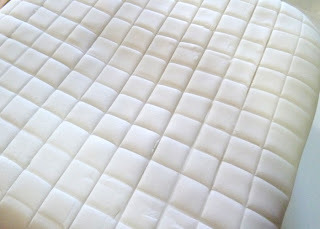 Grid lines!3. Mix up the black paste food colouring in a little bowl, with a few drops of water, to get a nice painting consistency. Practice on some scraps of icing first.
Grid lines!3. Mix up the black paste food colouring in a little bowl, with a few drops of water, to get a nice painting consistency. Practice on some scraps of icing first.
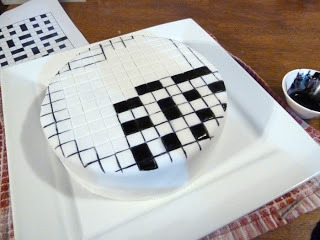 The round cake just started4. Paint in the indented lines (or use the pen, but I found the brush worked better), to draw the grid. Avoid leaning your hand on the cake, if you can help it (I didn't manage this well, though, LOL!). Rest your elbow on the bench, and hold the wrist of your painting hand with your other hand.
The round cake just started4. Paint in the indented lines (or use the pen, but I found the brush worked better), to draw the grid. Avoid leaning your hand on the cake, if you can help it (I didn't manage this well, though, LOL!). Rest your elbow on the bench, and hold the wrist of your painting hand with your other hand.
 The square cake in progress5. Colour in the squares that should be black, using your printed-out crossword as a guide. You can use kitchen paper or cotton buds dipped in clean water to carefully wipe away any mistakes. Work slowly and carefully! This part takes quite a while, I did it over several days. Good to do while watching NCIS.
The square cake in progress5. Colour in the squares that should be black, using your printed-out crossword as a guide. You can use kitchen paper or cotton buds dipped in clean water to carefully wipe away any mistakes. Work slowly and carefully! This part takes quite a while, I did it over several days. Good to do while watching NCIS.
6. Leave to dry overnight.
7. Using the edible ink pen, write in the tiny grid numbers to correspond with the crossword design you're using.
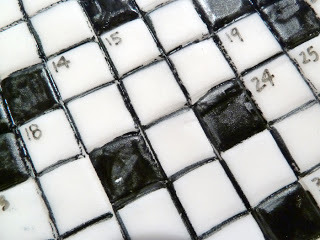
8. Ta dah! You're done!! Sit back and bask in the glow of your cleverness. Then nom it :)
If you really want to go to town, you can fill in some of the grid with appropriate words for the cakey occasion!


The recipe is my great-aunt's fruit cake. It's a boiled fruit cake, which means the dried fruit is boiled before baking, which makes it all soft and tender and nommy. This is the cake I made for my wedding cake, many years ago, in the mists of time.
It is also a very easy and inexpensive cake to make (always a plus)! Keep in mind that the whole decorating process takes quite a few days (as the marzipan layer needs to dry first), so this isn't a project to undertake in a rush at the last minute. There are quicker crossword biscuits at the end of this post, if you are in a hurry.
Aunty Joyce's Fruit Cake
500g sultanas120g dried orange peel (or you can substitute another dried fruit if you're not a fan of peel)250 g butter, chopped1 cup sugar1 cup plain flour1 cup self-raising flour3 eggs60-90 ml brandy
You will need:
a large saucepan - all mixing is done in the saucepan, so make sure it's large!a knife for cutting the buttera mixing spoonmeasuring cupsdeep cake panskewer of some sort for testing donenesswire cake cooling rack
1. Put the sultanas and peel (or chopped dried apricots, or currants, or whatever) into a large saucepan. Pour in enough water to cover the fruit. Bring to the boil, then simmer until all the liquid is absorbed, stirring occasionally. Remove from the heat.
2. Preheat the oven to 175ºC (NOT fan forced) or 165º fan-forced.
3. Stir in the chopped butter and sugar, mix until the sugar is dissolved and the butter is melted.
My goodness, doesn't it look yummy?

4. Mix in the flours, eggs, and brandy.

5. Grease and line a deep cake tin. If you're using a silicone pan, you don't need to line it, just greasing will do. Pour in the batter.
 6. Bake! My cakes usually take 70 minutes, but test yours at one hour. Allow to cool in the tin for a bit, then on a wire rack.
6. Bake! My cakes usually take 70 minutes, but test yours at one hour. Allow to cool in the tin for a bit, then on a wire rack.At this point you can just either wrap it in foil, to ice another day, or proceed to icing right away.
The Crossword Decoration
I got the basic idea and method for how to do this from the Cake or death? website (see the cryptic crossword cake close up, and Janet's decoration technique). This is her cryptic crossword cake, which I love. Looks, an icing pencil! She's gone as far as adding custom cryptic clues, a step I haven't done (this time!) ... the by Araucakia line is hilarious (a take on Araucaria, a famous UK cryptic setter). I also highly approve of her Eddie Izzard Cake or death? connection!

You will need:
apricot jammarzipan or almond cake paste (~600g)fondant icing (~600g)icing sugar (for dusting)black paste food colouringblack edible ink pen – I used the Jet Black Edible Food Penrolling pinpastry brushtiny paintbrushclean rulerprint out of an enlarged crossword
1. You need a basic marzipan and fondant icing coating on the cake. There are many online tutorials and videos on how to do this; I found these two useful:
How to marzipan a cake (VideoJug)Icing a fruit cake (BBC Good Food)
 The marzipan layerBasically, you coat the cake with a thin layer of strained, warm apricot jam. Then you roll out the marzipan layer and cover the cake with it. Then the cake needs to dry for several days. Finally, you roll out the fondant icing, and cover the cake with that.
The marzipan layerBasically, you coat the cake with a thin layer of strained, warm apricot jam. Then you roll out the marzipan layer and cover the cake with it. Then the cake needs to dry for several days. Finally, you roll out the fondant icing, and cover the cake with that. The apricot glaze ready to go
The apricot glaze ready to go
 Adding the fondant layer
Adding the fondant layer All neat and tidy!
All neat and tidy!Once the fondant icing has dried for a bit (at least 4-5 hours):
2. Using the back of a knife, or a very clean ruler edge, lightly press a regular grid design into the top of the cake. You don't want the lines to press down too far into the icing. You can also photocopy a crossword (enlarged) and use that as a guide, running a blunt edge over the lines, to lightly mark the icing surface.
 Ruling up the cake
Ruling up the cake Grid lines!3. Mix up the black paste food colouring in a little bowl, with a few drops of water, to get a nice painting consistency. Practice on some scraps of icing first.
Grid lines!3. Mix up the black paste food colouring in a little bowl, with a few drops of water, to get a nice painting consistency. Practice on some scraps of icing first.
 The round cake just started4. Paint in the indented lines (or use the pen, but I found the brush worked better), to draw the grid. Avoid leaning your hand on the cake, if you can help it (I didn't manage this well, though, LOL!). Rest your elbow on the bench, and hold the wrist of your painting hand with your other hand.
The round cake just started4. Paint in the indented lines (or use the pen, but I found the brush worked better), to draw the grid. Avoid leaning your hand on the cake, if you can help it (I didn't manage this well, though, LOL!). Rest your elbow on the bench, and hold the wrist of your painting hand with your other hand. The square cake in progress5. Colour in the squares that should be black, using your printed-out crossword as a guide. You can use kitchen paper or cotton buds dipped in clean water to carefully wipe away any mistakes. Work slowly and carefully! This part takes quite a while, I did it over several days. Good to do while watching NCIS.
The square cake in progress5. Colour in the squares that should be black, using your printed-out crossword as a guide. You can use kitchen paper or cotton buds dipped in clean water to carefully wipe away any mistakes. Work slowly and carefully! This part takes quite a while, I did it over several days. Good to do while watching NCIS.6. Leave to dry overnight.
7. Using the edible ink pen, write in the tiny grid numbers to correspond with the crossword design you're using.

8. Ta dah! You're done!! Sit back and bask in the glow of your cleverness. Then nom it :)
If you really want to go to town, you can fill in some of the grid with appropriate words for the cakey occasion!
Published on August 23, 2012 01:20



